What is a Monitor?
A monitor is an electronic output device that is also known as a video display terminal (VDT) or a video display unit (VDU). It is used to display images, text, video, and graphics information generated by a connected computer via a computer's video card. Although it is almost like a TV, its resolution is much higher than a TV. The first computer monitor was introduced on 1 March 1973, which was part of the Xerox Alto computer system.
Older monitors were built by using a fluorescent screen and Cathode Ray Tube (CRT), which made them heavy and large in size and thus causing them to cover more space on the desk. Nowadays, all monitors are made up by using flat-panel display technology, commonly backlit with LEDs. These modern monitors take less space on the desk as compared to older CRT displays.
History of Monitors
- In 1964, the Uniscope 300 machine included a built-in CRT display, which was not a true computer monitor.
- A. Johnson invented the touch screen technology in 1965.
- On 1 March 1973, Xerox Alto computer was introduced, which had the first computer monitor. This monitor included a monochrome display and used CRT technology.
- In 1975, George Samuel Hurst introduced the first resistive touch screen display, although it was used only before 1982.
- In 1976, the Apple I and Sol-20 computer systems were introduced. These systems had a built-in video port that allowed them to run a video screen on computer monitor.
- In 1977, James P. Mitchell invented LED display technology. But even 30 years later, these monitors were not easily available to buy in the market.
- In June 1977, the Apple II was released, allowing for color display on a CRT monitor.
- In 1987, IBM released the IBM 8513, first VGA monitor.
- In 1989, VESA defined the SVGA standard for the display of computers.
- In the late-1980s, the color CRT monitors were able to support 1024 x 768 resolution display.
- Eizo Nanao manufactured the Eizo L66, the first LCD monitors for desktop computers, and released it in the middle-1990s.
- In 1997, the color LCD monitors were started developing by IBM, Viewsonic, and Apple that provide better quality and resolution than CRT monitors.
- In 1998, the color LCD monitors for desktop computers were manufactured by Apple.
- Later in 2003, CRT monitors outsell for the first time by LCD monitors. Till 2007, CRT monitors consistently outsell by LCD monitors, so they become more popular computer monitor.
- In 2006, Jeff Han released the first interface-free, touch-based monitor at TED.
- In 2009, the LED monitor MultiSync EA222WMe was released by NEC company. It was the first monitor released by NEC.
- AMD and Intel announced to end support for VGA in December 2010.
- In 2017, touch screen LCD monitors became more affordable for the customers as they started to decrease the price.
Types of Monitors
There are several types of monitors; some are as follows:
1. Cathode Ray Tube (CRT) Monitors
It is a technology used in early monitors. It uses a beam of electrons to create an image on the screen. It comprises the guns that fire a beam of electrons inside the screen. The electron beams repeatedly hit the surface of the screen. These guns are responsible for generating RGB (Red, Green, Blue) colors, and more other colors can be generated with the help of combining these three colors. Today's Flat Panel Monitors replace the CRT monitors.
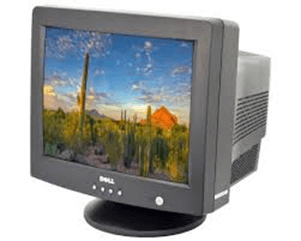
2. Flat Panel Monitors
These types of monitors are lightweight and take less space. They consume less power as compared to CRT monitors. These monitors are more effective as they do not provide harmful radiation. These monitors are more expensive than CRTs. The flat-panel monitors are used in PDA, notebook computers, and cellular phones. These monitors are available in various sizes like 15", 17", 18" & 19" and more. The display of a flat-panel monitor is made with the help of two plates of glass. These plates contain a substance, which is activated in many ways.

Flat-panel monitor screens use two types of technologies, which are given below:
- Liquid Crystal Display: LCD (Liquid crystal display) screen contains a substance known as liquid crystal. The particles of this substance are aligned in a way that the light located backside on the screens, which allow to generate an image or block. Liquid crystal display offers a clear picture as compared to CRT display and emits less radiation. Furthermore, it consumes less power and takes less space than a CRT display.
- Gas Plasma Display: This display uses gas plasma technology, which uses a layer of gas between 2 plates of glass. When voltage is applied, the gas releases ultraviolet light. By this ultraviolet light, the pixels on the screen glow and form an image. These displays are available in different sizes of up to 150 inches. Although it offers effective colors as compared to the LCD monitor, it is more expensive. That's why it is less used.
3. Touch Screen Monitors
These monitors are also known as an input device. It enables users to interact with the computer by using a finger or stylus instead of using a mouse or keyboard. When users touch the screen by their finger, it occurs an event and forward it to the controller for processing. These types of screens include pictures or words that help users to interact with the computer. It takes input from the users by touching menus or icons presented on the screen.
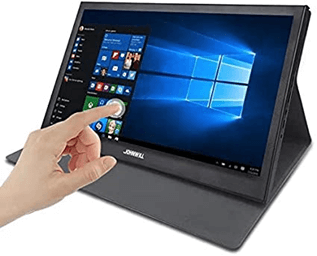
There are different types of touch screen monitors; three common types are given below:
- Resistive Touch Screen: Generally, this screen includes a thin electrically conductive and resistive layer of metal. When the touch is pressed, a change in the electrical current occurs that is sent to the controller. Nowadays, these screens are widely in use. These monitors are more reliable as they cannot be affected by liquids or dust.
- Surface Wave Touch Screens: These monitors process the input through ultrasonic waves. When a user touches the screen, the wave is processed and absorbed by the computer. It is less reliable as they can be damaged by water or dust.
- Capacitive Touch Screen: This screen includes a cover with an electrically-charged material. This material continuously flows the current over the screen. It is mainly used by the finger rather than a stylus. These monitors contain better clarity and do not damage by dust. Nowadays, capacitive touch screen is mostly used in smartphones.
4. LED Monitors
It is a flat screen computer monitor, which stands for light-emitting diode display. It is lightweight in terms of weight and has a short depth. As the source of light, it uses a panel of LEDs. Nowadays, a wide number of electronic devices, both large and small devices such as laptop screens, mobile phones, TVs, computer monitors, tablets, and more, use LED displays.
It is believed that James P. Mitchell invented the first LED display. On 18 March 1978, the first prototype of an LED display was published to the market at the SEF (Science and Engineering Fair) in Iowa. On 8 May 1978, it was shown again in Anaheim California, at the SEF. This prototype received awards from NASA and General Motors.
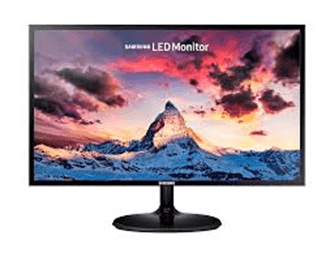
Advantages of LED Monitor:
- It includes a broader dimming range.
- It is a more reliable monitor.
- It is often less expensive.
- It consumes less power (20 watts), and run on a lower temperature.
- It has a more dynamic contrast ratio.
Comparison between LCD and LED monitors:
| Resolution 1920 x 1080 | LCD Monitors | Led Monitors |
| Brightness | 250 cd / m2 | 250 cd / m2 |
| Energy Star Certified | No | Yes |
| Weight | 2.4 kg | 2.4 kg |
| Contrast Ratio | 12,000,000: 1 | 100,000,000: 1 |
5. OLED Monitors
It is a new flat light-emitting display technology, which is more efficient, brighter, thinner, and better refresh rates feature and contrast as compared to the LCD display. It is made up of locating a series of organic thin films between two conductors. These displays do not need a backlight as they are emissive displays. Furthermore, it provides better image quality ever and used in tablets and high-end smartphones.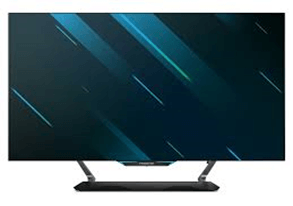
Nowadays, it is widely used in laptops, TVs, mobile phones, digital cameras, tablets, VR headsets. The demand for mobile phone vendors, more than 500 million AMOLED screens were produced in 2018. The Samsung display is the main producer of the AMOLED screen. For example, Apple is using AMOLED OLED panel made by SDC in its 2018 iPhone XS - a 5.8" 1125x2436. Additionally, iPhone X is also using the same AMOLED display.
6. DLP Monitors
DLP stands for Digital Light Processing, developed by Texas Instruments. It is a technology, which is used for presentations by projecting images from a monitor onto a big screen. Before developing the DLP, most of the computer projection systems produced faded and blurry images as they were based on LCD technology. DLP technology utilizes a digital micromirror device, which is a tiny mirror housed on a special kind of microchip. Furthermore, it offers better quality pictures that can also be visible in a lit room normally.
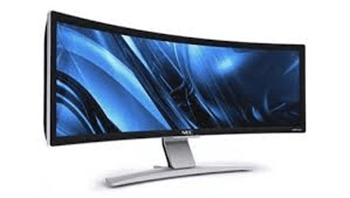
7. TFT Monitors
It is a type of LCD flat panel display, which stands for a thin-film transistor. In TFT monitors, all pixels are controlled with the help of one to four transistors. The high-quality flat-panel LCDs use these transistors. Although the TFT-based monitors provide better resolution of all the flat-panel techniques, these are highly expensive. The LCDs, which use thin-film transistor (TFT) technology, are known as active-matrix displays. The active-matrix displays offer higher quality as compared to older passive-matrix displays.
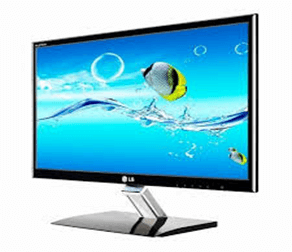
8. Plasma Screen Monitors
A plasma screen is a thin, flat-panel, and capable of hanging on a wall like LCD and LED televisions. It is a brighter screen as compared to LCD displays and thinner than CRT displays. It can be used to either display modes of digital computer input or analog video signals, and sometimes, it is marketed as 'thin-panel' displays. Plasma displays have wide viewing angles, high contrast ratios, and high refresh rates, which is used to reduce a blur video. Additionally, it provides better quality pictures as it supports high resolutions of up to 1920 x 1080.
The plasma screen also includes some disadvantages such as the chance of screen burn-in, consumes more power, loss of brightness with time, can be heavier in weight.
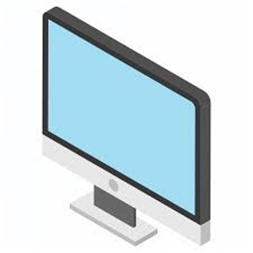
Types of monitor connector
Computer monitors require one of the following kinds of connectors to connect with a computer.
- VGA
- Thunderbolt
- HDMI
- USB-C
- DVI
- DisplayPort
VGA: It is a popular display standard, stands for Video Graphics Array or Video Graphics Adapter. It was introduced in 1987 after being developed by IBM. It is used to connect a computer with a projector, monitor, or TV. It offers a 640 x 480 resolution color display, including 16 colors display and a refresh rate of 60 Hz at a time. If the resolution is less than 320 x 200, it displays 256 colors. It is only able to show lower quality, and lower resolutions display on the screens as it uses analog signals. The VGA connector and cable are less found with today's projectors, monitors, computers, and TVs. These connectors are being replaced by HDMI and DVI cable and connectors.
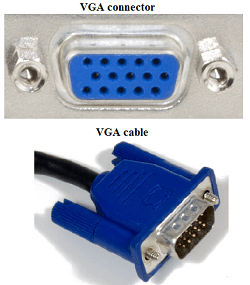
Thunderbolt: It is a hardware interface, which was marketed under the name Light Peak and developed by Intel in collaboration with Apple. On 24 February 2011, it was first sold as part of a consumer product. It is used for connecting peripheral devices such as a mouse, keyboard, printer, scanner, and more to a computer. It is capable of carrying DC power and has the ability to transfer the data on long-distance over cheaper cables. The first two versions of Thunderbolt are capable of transferring the data at a rate of up to 20 Gb in a second. The 3rd iteration is capable to use a USB Type-C connector and can transfer data at a rate of up to 40 Gb per second.
What materials are used to make a Thunderbolt cable?
The two types of Thunderbolt cables are available where one uses optical wiring, and another uses copper wiring. Although Thunderbolt cables were designed to use as fiber optic cables, those versions were released in fewer numbers. Copper wiring allows the cables to supply power, and it is less expensive, that's why it was widely used. Afterall, intel intends to use the power of copper wiring to provide faster bandwidth speeds of optical by combining both optical and coper wiring.
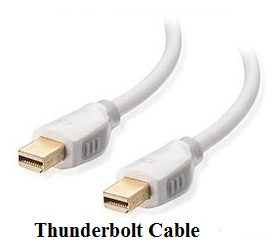
HDMI: It is a cable and connector developed by several companies, including Toshiba, Sony, Hitachi, and Philips. It stands for High Definition Multimedia Interface. It has the ability to transmit the high-bandwidth and high-quality streams of audio and video between devices. It is used with Projector, HDTV, Blu-ray player, or DVD player.
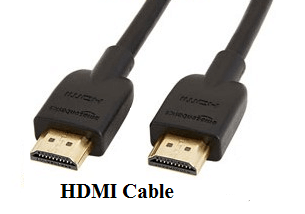
A single HDMI cable provides an easier way to connect two devices together for transmitting audio and video signals by replacing the three-composite audio/video cables. Furthermore, it is able to transmit up to 8-channels of digital audio signals, including enhanced, standard, and high-definition video signals. The HDMI cable is available in various length of up to 50 feet. Although, it is not recommended to purchase a cable of length more than 25 feet because it may occur a problem of signal loss or degradation.
USB-C: It is a plug and play interface, stands for Universal Serial Bus. It allows the computer to communicate with peripheral and other devices. It is also able to send power to certain devices like tablets and smartphones, including charging their batteries. In January 1996, the first version of the Universal Serial Bus was released. Then, this technology was followed by Compaq, Intel, Microsoft, and other companies.
Nowadays, there are several USB devices that can be connected to a computer such as Digital Camera, Keyboard, Microphone, Mouse, Printer, Scanner, and more. Furthermore, USB connectors are available in different shapes and sizes. The length of a USB cable used for high-speed devices is 16 feet 5 inches (its maximum length), and 9 feet 10 inches is used for low-speed devices.
DVI: It is a video display interface, stands for Digital Visual Interface. It is used to transmit Digital Visual Interface and display devices at high 2560 x 1600 resolutions. Computer monitors and projectors are the common devices that use the DVI connection. It can also be used by some TVs; however, HDMI is most common because only some DVI cables have the ability to transmit audio signals.
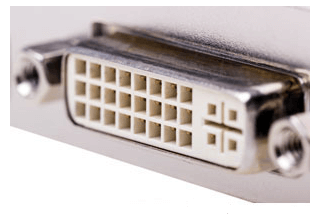
The DVI connector supports one of three names on the basis of the signals: DVI-D (support the only digital), DVI-A (support the only analog), or DVI-I (support both analog and digital). If your GPU and monitor have the capability to support both VGA and DVI, it is suggested to use DVI cable. The DVI cable always provides picture quality at least equal to VGA and better if possible.
DisplayPort: It is a digital audio and video interface that connects to a projector, monitor, or TV cable. It is created by VESA. There are two types of connections in DisplayPort one is standard, and the second is the Mini DisplayPort. They have different size, but both connections types are able to transmit identical signals. Nowadays, VGI, HDMI, and DVI are the most common types of display ports.

Difference between LCD and LED
The below table contains several differences between LCD and LED:
| LCD | LED |
|---|---|
| It stands for Liquid Crystal Display. | Short for Light-Emitting Diodes. |
| LCD monitors are not a subset of LED monitors. | LED monitors are subset of LCD monitors. |
| It primarily uses fluorescent lights. | It mainly uses light-emitting diodes. |
| In LCDs, usually fluorescent lights are located at the backside of the screen. | Usually, light-emitting diodes are located around the edges or backside of the screen. |
| LCDs are less energy efficient than LEDs and are thicker in size. | LEDs are more energy-efficient and are much thinner in size as compared to LCDs. |
| Its resolution is low. | Its resolution is high. |
| Its contrast ratio is high. | Its contrast ratio is low. |
| Direct current can reduce the span life of LCDs. | Direct current does not have any effect on LEDs. |
| LCDs display area is large. | LEDs display area is small. |
| The switching time of LCD is slow. | The switching time of LED is fast. |


No comments:
Post a Comment